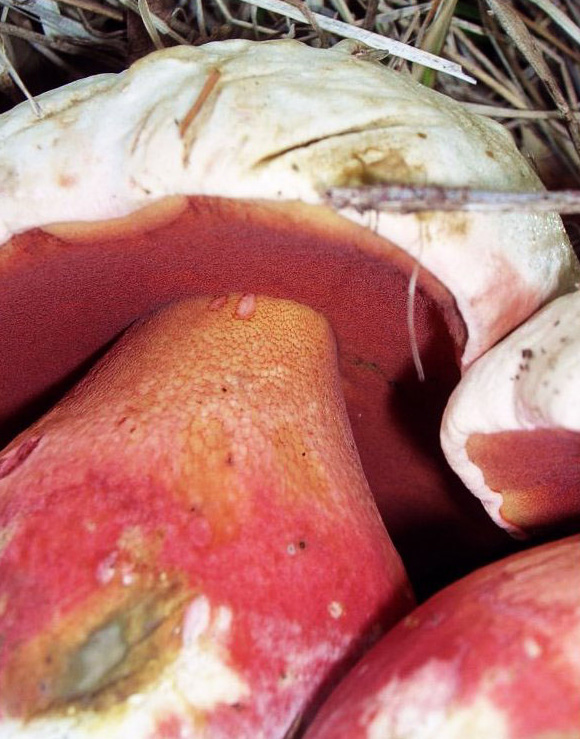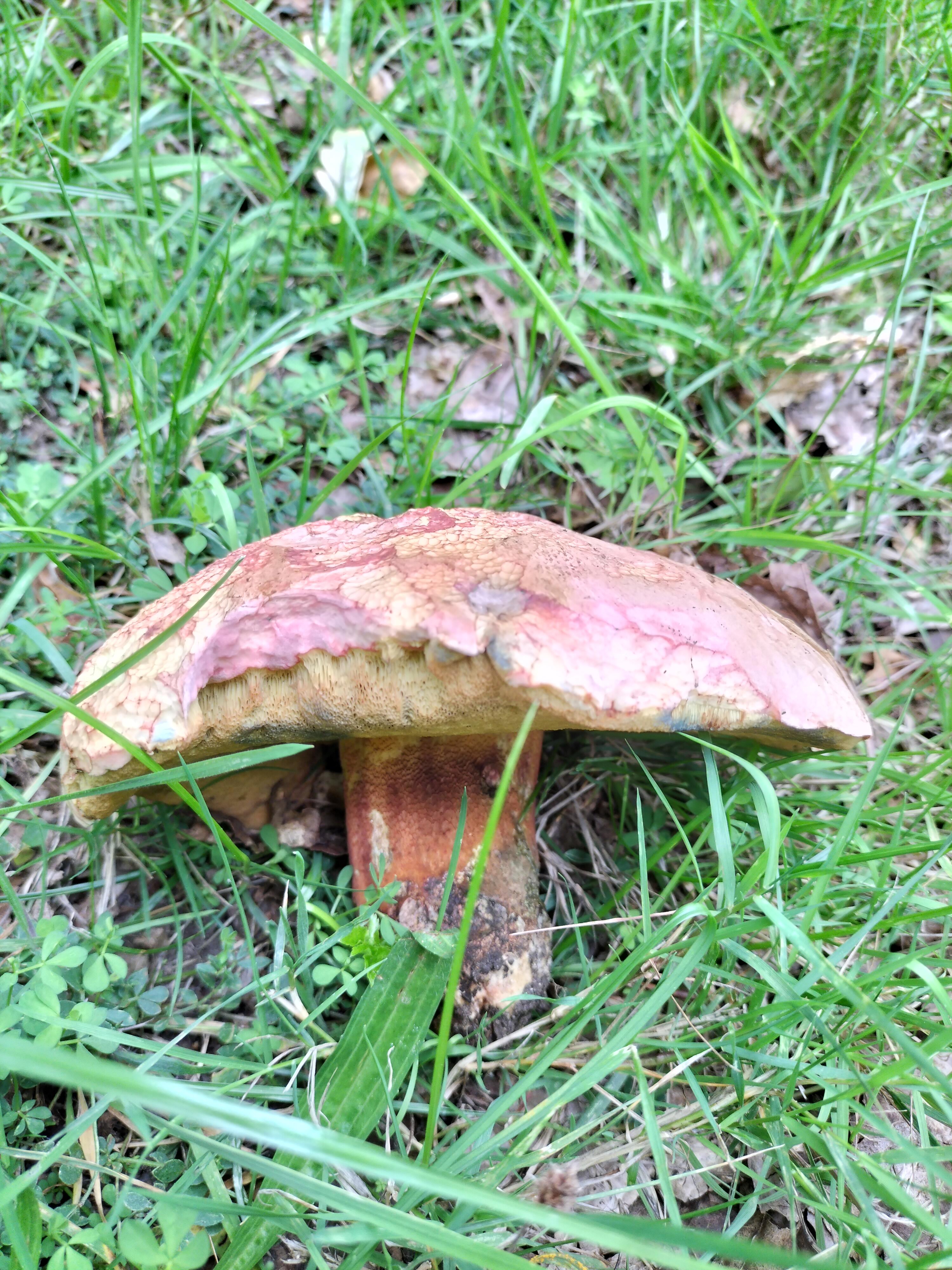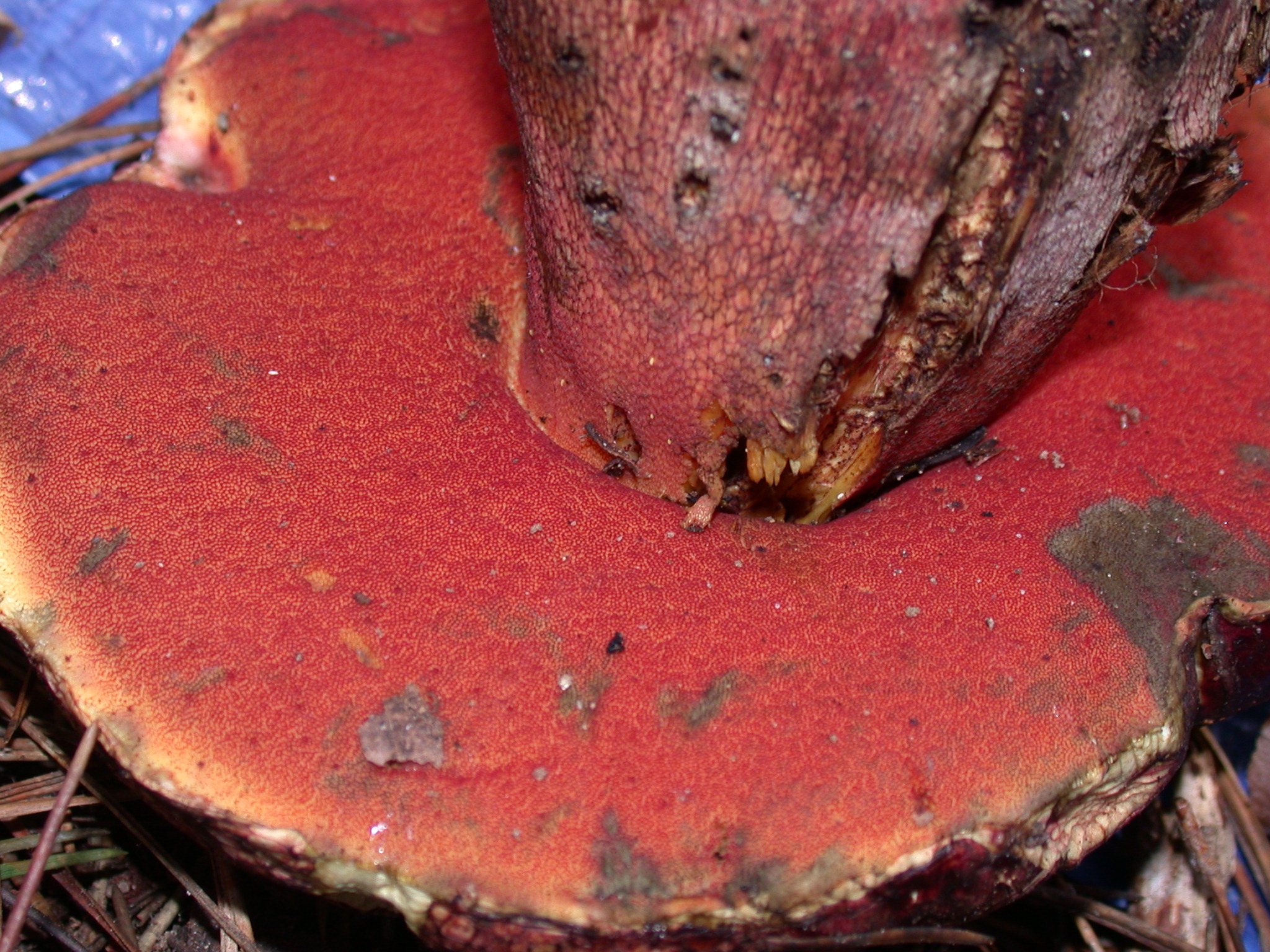|
Rubroboletus
''Rubroboletus'' is a genus of bolete fungi in the family Boletaceae. It was circumscribed by Chinese mycologists in 2014 with '' Rubroboletus sinicus'' as the type species. Species are characterized by having a reddish cap surface, yellow tubes on the underside of the cap, and an orange-red to blood-red pore surface. Pinkish to red spots (reticula) are present on the stipe surface, and a bluish color change occurs when the bolete flesh is injured. ''Rubroboletus'' mushrooms have an olive-brown spore print, and produce smooth spores. Eight species were included in the original circumscription (seven new combinations and one new species); five were added in 2015, and another in 2017. Although ''R. sinicus'' is sold in markets in Yunnan, China, the whole genus is usually deemed poisonous. Species *''Rubroboletus dupainii'' (Boud.) Kuan Zhao & Zhu L.Yang 2014 * ''Rubroboletus eastwoodiae'' (Murrill) D.Arora, C.F.Schwarz & J.L.Frank 2015 *'' Rubroboletus esculentus'' Zhao ... [...More Info...] [...Related Items...] OR: [Wikipedia] [Google] [Baidu] |
Rubroboletus
''Rubroboletus'' is a genus of bolete fungi in the family Boletaceae. It was circumscribed by Chinese mycologists in 2014 with '' Rubroboletus sinicus'' as the type species. Species are characterized by having a reddish cap surface, yellow tubes on the underside of the cap, and an orange-red to blood-red pore surface. Pinkish to red spots (reticula) are present on the stipe surface, and a bluish color change occurs when the bolete flesh is injured. ''Rubroboletus'' mushrooms have an olive-brown spore print, and produce smooth spores. Eight species were included in the original circumscription (seven new combinations and one new species); five were added in 2015, and another in 2017. Although ''R. sinicus'' is sold in markets in Yunnan, China, the whole genus is usually deemed poisonous. Species *''Rubroboletus dupainii'' (Boud.) Kuan Zhao & Zhu L.Yang 2014 * ''Rubroboletus eastwoodiae'' (Murrill) D.Arora, C.F.Schwarz & J.L.Frank 2015 *'' Rubroboletus esculentus'' Zhao ... [...More Info...] [...Related Items...] OR: [Wikipedia] [Google] [Baidu] |
Rubroboletus Satanas
''Rubroboletus satanas'', commonly known as Satan's bolete or the Devil's bolete, is a basidiomycete fungus of the bolete family (Boletaceae) and one of its most infamous members. It was known as ''Boletus satanas'' before its transfer to the new genus ''Rubroboletus'' in 2014, based on molecular phylogenetic data. Found in broad-leaved and mixed woodland in the warmer regions of Europe, it is classified as a poisonous mushroom, known to cause gastrointestinal symptoms of diarrhea and violent vomiting. However, reports of poisoning are rare, due to its striking appearance and at times putrid smell, which discourage casual experimentation. The squat, brightly coloured fruiting bodies are often massive and imposing, with a pale, dull-coloured velvety cap up to , extraordinarily , very rarely across, yellow to orange-red pores and a bulbous red-patterned stem. The flesh turns blue when cut or bruised, and overripe fruit bodies often emit an unpleasant smell reminiscent of carrio ... [...More Info...] [...Related Items...] OR: [Wikipedia] [Google] [Baidu] |
Rubroboletus Rhodoxanthus
''Rubroboletus rhodoxanthus'' is a species of bolete in the family Boletaceae, native to Europe. Previously known as ''Boletus rhodoxanthus'', it was transferred in 2014 to the newly erected genus '' Rubroboletus'', based on DNA data. It produces large, colourful fruit bodies with pink patches on the cap, red pores in the hymenial surface and has a robust stem decorated in a dense, red-coloured network pattern. When longitudinally sliced, its flesh is distinctly bright yellow in the stem and discolours blue only in the cap, an excellent diagnostic feature distinguishing it from similar species. The fungus is more widespread in warm broad-leaved forests of southern Europe, where it grows in mycorrhizal symbiosis with trees of the family Fagaceae, particularly oak (''Quercus'') and beech ('' Fagus''). However, it is rare in northern regions and regarded as critically endangered or extinct in some countries. ''Rubroboletus rhodoxanthus'' is generally regarded as inedible an ... [...More Info...] [...Related Items...] OR: [Wikipedia] [Google] [Baidu] |
Boletaceae
The Boletaceae are a family of mushroom-forming fungi, primarily characterised by small pores on the spore-bearing hymenial surface (at the underside of the mushroom), instead of gills as are found in most agarics. Nearly as widely distributed as the agarics, the family is renowned for hosting some prime edible species highly sought after by mushroom hunters worldwide, such as the cep or king bolete (''Boletus edulis''). A number of rare or threatened species are also present in the family, that have become the focus of increasing conservation concerns. As a whole, the typical members of the family are commonly known as boletes. Boletes are a group of mushrooms reasonably safe for human consumption, as none of them are known to be deadly to adults. Edible bolete species are especially suitable for novice collectors, since they pose little danger of being confused with deadly poisonous mushrooms, such as deadly ''Amanita'' species which bear gills instead of pores in their hym ... [...More Info...] [...Related Items...] OR: [Wikipedia] [Google] [Baidu] |
Rubroboletus Legaliae
''Rubroboletus legaliae'', previously known as ''Boletus splendidus'', ''B. satanoides'', and ''B. legaliae'' is a basidiomycete fungus of the family Boletaceae. It is poisonous, with predominantly gastrointestinal symptoms, and is related to ''Rubroboletus satanas''. ''Boletus legaliae'' was described by Czech mycologist Albert Pilát in 1968. It is named after the French mycologist Marcelle Le Gal. It's uncommon in Southern England, and Europe, and grows with oak (''Quercus'') and beech ('' Fagus'') often on neutral to acid soils. It is considered vulnerable in the Czech Republic. In Britain, all of the boletes in the ''Satanas'' group are either very rare, endangered, or extinct. Description The cap is initially off-white, or coffee-coloured at the button stage. In mid life it often (but not always) turns a pale mouse grey. In old age the cap turns reddish, or what has been described as 'old rose'. It may reach in diameter. The stipe is stocky, with a narro ... [...More Info...] [...Related Items...] OR: [Wikipedia] [Google] [Baidu] |
Rubroboletus Dupainii
''Rubroboletus dupainii'', commonly known as Dupain's bolete, is a bolete fungus of the genus ''Rubroboletus''. It is native to Europe, where it is threatened, and red listed in six countries. It also occurs in North America, although it is rare there. It was first recorded from North Carolina, and then from Iowa in 2009. It was reported from Belize in 2007, growing under ''Quercus peduncularis'' and other oaks. The bolete was first described scientifically by French mycologist Jean Louis Émile Boudier in 1902. It was transferred to the new genus ''Rubroboletus'' in 2014 along with several other allied reddish colored, blue-staining bolete species. Phylogenetically, ''R. dupainii'' is the sister species of '' Rubroboletus lupinus''. See also *List of North American boletes __NOTOC__ This is a list of bolete species found in North America. Bolding of the species name, and an asterisk (*) following indicate the species is the type species of that genus. '' Aureoboletus'' *'' ... [...More Info...] [...Related Items...] OR: [Wikipedia] [Google] [Baidu] |
Rubroboletus Eastwoodiae
''Rubroboletus eastwoodiae'', or satan's bolete, is a toxic basidiomycete fungus of the bolete family. It occurs on the West Coast of the United States. It is closely related to ''Rubroboletus pulcherrimus''. The mushroom turns blue with bruising. The cap is 10–25 cm wide, convex, olive-colored, pinkish in age, dry, has margin that curves inward then expands, and yellowish flesh. The stalk is 7–15 cm tall and 3–6 cm wide. The spores are olive-brown, elliptical, and smooth. It may be poisonous. It looks similar but is not conspecific with the European species'' Rubroboletus satanas''. It is also similar to ''Boletus pulcherrimus ''Rubroboletus pulcherrimus''—known as ''Boletus pulcherrimus'' until 2015—is a species of mushroom in the family Boletaceae. It is a large bolete from Western North America with distinguishing features that include a netted surface on the ...'' and '' B. amygdalinus''. References {{Taxonbar, from1=Q57832964, from2=Q1835 ... [...More Info...] [...Related Items...] OR: [Wikipedia] [Google] [Baidu] |
Rubroboletus Rubrosanguineus
''Rubroboletus rubrosanguineus'' is a species of bolete fungus in the family Boletaceae that is found in Europe. Taxonomy The bolete was first described from the former Czechoslovakia as a subspecies of ''Boletus splendidus'' (now '' Boletus legaliae''), and later promoted to species status (as ''Boletus rubrosanguineus'') by Jean-Louis Cheype in 1983. Its species name comes from the Latin words ''ruber'' "red" and ''sanguineus'' "bloody". It was transferred to the new genus ''Rubroboletus'' in 2014 along with several allied reddish, blue-staining bolete species. Molecular analysis of eight of the member species found it was most closely related to '' Rubroboletus sinicus'' and formed a larger clade with '' R. satanas'' and '' R. pulchrotinctus'' Description The large stout fruit bodies have light to dark grey or grey-brown caps, often with pinkish margins, that may reach 15 cm (6 in) in diameter. Initially hemispherical (dome-shaped), they become convex t ... [...More Info...] [...Related Items...] OR: [Wikipedia] [Google] [Baidu] |
Rubroboletus Pulcherrimus
''Rubroboletus pulcherrimus''—known as ''Boletus pulcherrimus'' until 2015—is a species of mushroom in the family Boletaceae. It is a large bolete from Western North America with distinguishing features that include a netted surface on the stem, a red to brown cap and stem color, and red pores that stain blue upon injury. Until 2005 this was the only bolete that has been implicated in the death of someone consuming it; a couple developed gastrointestinal symptoms in 1994 after eating this fungus with the husband succumbing. Autopsy revealed infarction of the midgut. Taxonomy American mycologists Harry D. Thiers and Roy E. Halling were aware of confusion on the west coast of North America over red-pored boletes; two species were traditionally recognised—'' Boletus satanas'' and '' Boletus eastwoodiae''. However, they strongly suspected the type specimen of the latter species was in fact the former. In reviewing material they published a new name for the taxon, which Thie ... [...More Info...] [...Related Items...] OR: [Wikipedia] [Google] [Baidu] |
Rubroboletus Lupinus
''Rubroboletus lupinus'', commonly known as the wolf bolete, is a bolete fungus of the genus ''Rubroboletus''. Originally described by Elias Magnus Fries in 1838 as species of ''Boletus'', it was transferred to ''Rubroboletus'' in 2015, a genus circumscribed to host other allied reddish-colored, blue-staining bolete species forming a distinct clade. The species epithet is derived from the Latin word ''lupus'', meaning "wolf". Molecular studies have revealed considerable genetic variation among European populations of ''R. lupinus'', placing it in a clade sister to ''Rubroboletus dupainii''. The species is found in warm broad-leaved forests, forming ectomycorrhizal associations with various species of oak (''Quercus'') and sweet chestnut ('' Castanea''). References External links * lupinus ''Lupinus'', commonly known as lupin, lupine, or regionally bluebonnet etc., is a genus of plants in the legume family Fabaceae. The genus includes over 199 species, with centers ... [...More Info...] [...Related Items...] OR: [Wikipedia] [Google] [Baidu] |
Rubroboletus Haematinus
''Rubroboletus haematinus'' is a bolete fungus of the genus ''Rubroboletus''. First described scientifically in 1976 by Roy Halling as a species of ''Boletus'', in 2015 it was transferred to ''Rubroboletus'', a genus circumscribed the year previously to contain other allied reddish colored, blue-staining bolete species. It is found in the western United States. See also *List of North American boletes __NOTOC__ This is a list of bolete species found in North America. Bolding of the species name, and an asterisk (*) following indicate the species is the type species of that genus. ''Aureoboletus'' *'' Aureoboletus auriporus'' *'' Aureoboletus ... References External links * Fungi described in 1976 Fungi of the United States haematinus Fungi without expected TNC conservation status {{Boletales-stub ... [...More Info...] [...Related Items...] OR: [Wikipedia] [Google] [Baidu] |
Rubroboletus Rhodosanguineus
''Rubroboletus rhodosanguineus'' is a fungus of the genus ''Rubroboletus ''Rubroboletus'' is a genus of bolete fungi in the family Boletaceae. It was circumscribed by Chinese mycologists in 2014 with '' Rubroboletus sinicus'' as the type species. Species are characterized by having a reddish cap surface, yellow tub ...'' native to North America. It was described scientifically by mycologist Ernst Both in 1998. It was transferred from '' Boletus'' to the new genus ''Rubroboletus'' in 2014, along with several other allied reddish colored, blue-staining bolete species. See also * List of North American boletes References External links * rhodosanguineus Fungi described in 1998 Fungi of North America Fungus species {{Boletales-stub ... [...More Info...] [...Related Items...] OR: [Wikipedia] [Google] [Baidu] |




